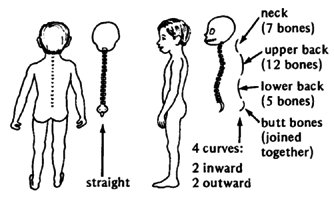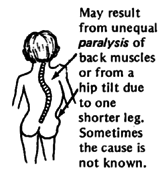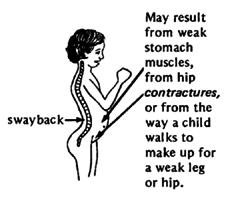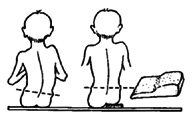CHAPTER 20
Spinal Curve and
Other Back Deformities

The backbone, or 'spine', is a chain of bones called 'vertebrae' that connect the head to the hipbone. Separating each of the vertebrae is a small cushion called a 'disk'. The backbone holds the body and head upright. It also encloses, in its hollow center, the 'spinal cord' or trunk line of nerves connecting the brain to all parts of the body (see Page 35).
| NORMAL SHAPE OF THE BACKBONE
Normally, the backbone (and back) is straight when seen from the back, and has 4 curves when seen from the side. |
| Sideways curve (scoliosis -
S-shaped curve)
|
Rounded back (kyphosis)
|
| Swayback (lordosis)
|
Sharp bend or bump in spine
(tuberculosis of the backbone)
|
Of these different problems, scoliosis or a sideways curve is the most common serious problem. Often, however, rounded and/or swayback are seen together with scoliosis.
NON-FIXED AND FIXED SPINAL CURVES
With a non-fixed or 'functional' curve there is no deformity of the vertebrae. This usually happens when the body tries to stand straight even though the hips tilt or there is other unevenness not in the spine.
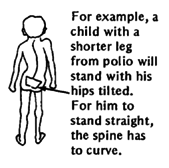
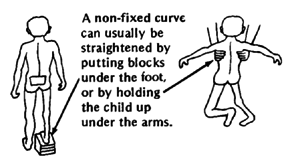

Fixed or 'structural' curves are deformities in the bones of the back themselves.
| Note: In some cases, with time a non-fixed curve may gradually become fixed. |
CAUSES OF SPINAL CURVE (SCOLIOSIS)
Most scoliosis (about 80%) occurs in otherwise healthy children for no known reason. Sometimes it occurs in several members of the same family, so there may be a hereditary (familial) factor. Although about 1 of every 10 persons has some scoliosis (if looked for), only about 1 in 400 has enough of a curve to be a problem. Curves of unknown cause are often first seen-and progress quickly-in children from 10-16 years old, during the period of rapid growth.
Known causes of fixed scoliosis range from infection to tumor to rare disease. When possible, consult a doctor with experience in these problems.

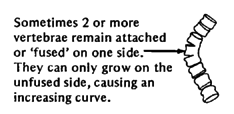
These problems can only be identified by X-rays.
Some children are born with fixed scoliosis, or develop it in early childhood, because of defects in the spine itself.
Non-fixed scoliosis always results secondary to other problems, such as uneven paralysis of the back muscles, or a hip tilt (often due to a shorter leg). Spinal curve often develops in children with polio, cerebral palsy, muscular dystrophy, spina bifida, spinal cord injury, arthritis, and dislocated hip. Be sure to examine all children with these disabilities for spinal curve. With time, non-fixed curves may gradually become fixed.
Examining for spinal curve
This is discussed in the chapter on physical examination (Chapter 4).
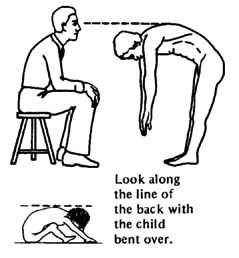
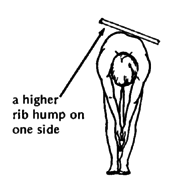
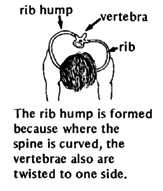
POSSIBLE SIGNS OF EARLY SCOLIOSIS
|
CHECK FOR:
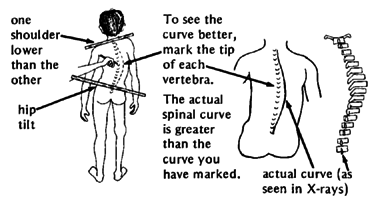

When you examine for scoliosis, also check to see if the curve


What to do
This will depend on:
| how severe the curve is. | |
| if it is getting worse-and if so, how quickly. | |
| whether the curve is fixed. | |
| the age of the child. |
| In a child who does not stand, check spinal curve while he
is sitting. If one side of his butt is weaker and smaller, it
may cause a hip tilt.
Put a book or board under the weaker butt, and see if this straightens his spine. If so, a cushion raised on one side may help him sit straighter. |
How severe the curve is and whether it is getting worse can be best measured by X-rays.

1 . For each curve, pick the 2 vertebrae that tilt most in relation to each other.
2. Draw lines level with the top of each vertebra.

3. Measure and record the angle of the spinal curve.
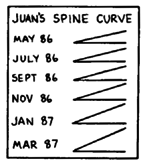
4. Regularly record the curve and notice any changes.
Because X-rays are expensive and often hard to get, you can get some idea of whether the curve is getting worse by measuring the angle of the rib hump.

Be sure the top piece is completely level. You can use a carpenter's level or a homemade one (see box).
Have the child stand or sit as straight as possible, while he bends forward.
| A homemade level for measuring rib hump angle
Fill the tube with colored water so that the water reaches the top edge of the board at both ends when level.
piece of thin plastic tube (old I.V. tube) When measuring the rib hump, level the top by making sure the water is at the top edge of the board at both ends. |
If the rib hump angle stays about the same month after month, the curve is probably not getting worse. Keep checking it every few months. If the rib hump angle increases steadily, the curve is getting worse. X-rays should be taken and a decision made about what to do.
Non-fixed curves that are not getting worse should usually be treated only by doing something about the underlying problem.
For example, if the child's spinal curve is not fixed and comes from a hip tilt due to unequal leg length:
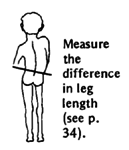
|
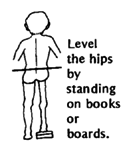
|

|

|
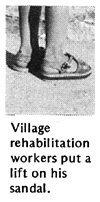
|

|
Body jackets or bracing for a non-fixed curve usually do not help to correct the curve or even to prevent its getting worse. However, for a child with a curve so severe that it makes sitting or walking difficult, a body jacket or corset may help.
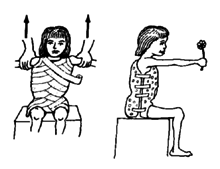
Instructions for making body jackets are on Page 558 |
Spinal curves under 20° (fixed or non-fixed) usually need no special care - other than to be watched, and measured every few months to see if they are getting worse.
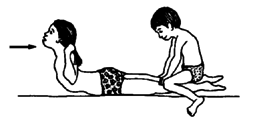
Some experts say that exercises to strengthen the back muscles, like this, help correct and slow down the curving of the spine. Other experts say it does no good. (We do not know.)
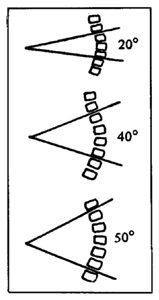
Spinal curves over 20°, if they are fixed and getting worse, may get worse less quickly with a brace.
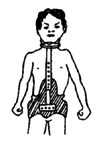
A brace like this (the Milwaukee brace) is often used. It works because it is so uncomfortable that the child must stretch his body as straight as possible to reduce the discomfort.

A plastic 'Boston brace' like this is more comfortable, can be completely hidden under the clothes, and probably does as much good.
SURGERY
For spinal curves over 50° which are quickly getting worse, surgery may be needed. Surgery 'fuses' (joins together) the most affected vertebrae. Usually it only partly straightens the spine. Except for very severe curves, surgery should be avoided in children under 12 years old because the fused part of the spine will not grow any more.
If the curve of the spine is less than 40° by the time the child stops growing, usually it will not progress further. If the curve is over 50°, it is likely to keep getting worse even after the child stops growing, and surgery is often recommended.
However, 'spinal fusion' surgery is very costly and requires an orthopedic surgeon specially trained in this operation. It can also be very hard on the child and family. When surgery cannot be obtained, a body jacket or brace should perhaps be used to help slow down the curve's progress. When a curve becomes too severe, there is no longer enough room in the chest for the lungs and heart to work well, and the child may get pneumonia and die.
EXERCISES FOR ROUNDED BACK AND SWAYBACK

Children with rounded back may benefit from exercises to help straighten it, like this.
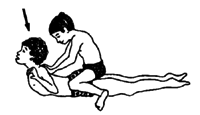
These exercises are explained in the Exercise Sheet #5, Page 387.
The child should also be encouraged to sit and stand as straight as possible, with the shoulders back.

Children with swayback may benefit from exercises to strengthen the stomach muscles, like this,
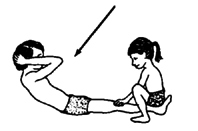
or by exercises to correct hip contractures (if the child has them). See Exercise Sheet #3, Page 385.

